Team-BHP
(
https://www.team-bhp.com/forum/)
Quote:
Originally Posted by V.Narayan
(Post 3743450)
Dear Peter, The Shin Meiwa US-2 would be our ideal long range search & rescue patrol aircraft. Various international maritime treaties spell out the search & rescue zones of each nation. India's zones are shown in the chart below. As you can see it extends to Mauritius to the West the whole of the Bay of Bengal to the East. It is our zone of responsibility and care where search & rescue go - all 4.6 million sq kms of it.
|
Oh we have something like that. Search and Rescue Region. I was never aware of something like this.
In this case, it will be the Navy's or CG's duty to cover this area, working with merchant ships and shipping vessels in the region. So we have Neptunes for Long range Reconnaissance and Dorniers for short range. Apparently just SeaKings and other rotary platforms (not dedicated for Search and Rescue Missions).
So US2 will be an all rounder which can do all of them together. Thanks
Quote:
Originally Posted by V.Narayan
(Post 3743450)
A fast flying seaplane with long legs is the best answer. The Shin Meiwa US-2 is the only one in production today.
|
No it isn't, meet the Be-200.
https://en.wikipedia.org/wiki/Beriev_Be-200
It's a jet, so faster, uses Coanda effect for short take off/landing runs and I think it's only shortcoming is the range. Something like 3 times that would give it incredible endurance and reach into deep ocean SAR missions. It can be given inflight refuelling capability though, if I remember correctly.
Quote:
Originally Posted by Ricci
(Post 3743822)
|
Dear Ricci, Would you know when the last Be-200 was built. - Thanks, Narayan
Quote:
Originally Posted by V.Narayan
(Post 3743854)
Dear Ricci, Would you know when the last Be-200 was built. - Thanks, Narayan
|
Not seen confirmed reports, but it is going on at low rates, perhaps 3-4 a year.
As of 2014, they were to be manufactured in US as well.
http://fireaviation.com/2014/09/28/n...us-air-tanker/
I wouldn't lay much by reports in the press and air shows - our industry is famous for big statements. I believe the last was assembled in 2010 to best of my knowledge. though the ability to start production still exists.
Quote:
Originally Posted by Ricci
(Post 3743822)
No it isn't, meet the Be-200.
It's a jet, so faster, uses Coanda effect for short take off/landing runs and I think it's only shortcoming is the range. Something like 3 times that would give it incredible endurance and reach into deep ocean SAR missions. It can be given inflight refuelling capability though, if I remember correctly.
|
Thanks for introducing Be-200. This looks formidable, and it has a great operational history looking at the Wiki Page.
Quote:
Originally Posted by V.Narayan
(Post 3743867)
I wouldn't lay much by reports in the press and air shows - our industry is famous for big statements. I believe the last was assembled in 2010 to best of my knowledge. though the ability to start production still exists.
|
Yes, the information especially on Russian/Soviet planes are very minimal. We would never know of whether they are building it or not. Another important thing to note here is, though Be-200 has a great operational history, the Russian Military has not bought many examples of the same. And also it never talks about the plane as if it was a successful project.
http://timesofindia.indiatimes.com/c...w/48243765.cms http://www.thehindu.com/news/cities/....ece?css=print
News articles indicate INS Viraat could be converted into a floating museum funded and supported by a State Government. The State of Andhra Pradesh has tossed its hat into the ring and Karnataka may also try. This is heartening news for us as the old lady will not suffer the fate of R11 INS Vikrant which sadly went to the breakers as no one was available to fund her. Andhra Pradesh has a proven track record of preserving ships as museums - INS Kursura in Vizag.
INS Viraat started life as HMS Hermes in the Royal Navy of the UK. She was laid down in 1945 and then put on hold as World War II ended. The 1940s and 1050s were times of great advances in both aircraft technology and in Naval aviation. The British Admiralty took the opportunity to rebuild the HMS Hermes to a wholly modern design with steam catapults, mirror deck landing aids and an angled flight deck - all three were British inventions. All these enabled her to operate large capable jet fighters and attack aircraft. In the 1970s she was converted to a Harrier Carrier ie for V/STOL operations. V/STOL stands for Vertical or Short Take-Off and Landing. She became the first ship in the world to feature a ski jump - a British invention.
In 1982, Britain's ability to re-take the Falkland Islands rested primarily on HMS Hermes and a new smaller Harrier Carrier the HMS Invincible. Harriers flown off these two ships flew air defence and ground attack sorties and shot down 20 Argentinean aircraft in return for loss of only two of their own to enemy ground fire.
In 1986 HMS Hermes was sold to India, given a deep refit and joined the fleet at Mumbai in 1987. In Indian Naval service she operated mainly Sea Harriers for fighter air cover, ground attack and anti-ship missions and Westland Sea Kings for Anti-Submarine Warfare. She is today the oldest major warship and the oldest carrier in service in any Navy across the globe. The delays in the commissioning of INS Vikramaditya led to her service life getting extended unduly. Commissioned in 1959 she is today 56 years old. The fact that we have kept her operational this long is a tribute to the engineers of the Indian Navy and the dockyard hands who soldiered to keep her in ship-shape. Today as the mighty ship gets ready to bow out of service we salute the men, both Indian and British, who served on board.
The photos below depict INS Viraat through the various stages of her life in chronological order. The next section depicts the different types of aircraft that served on board over a long career from 1959 to date.
The Ship 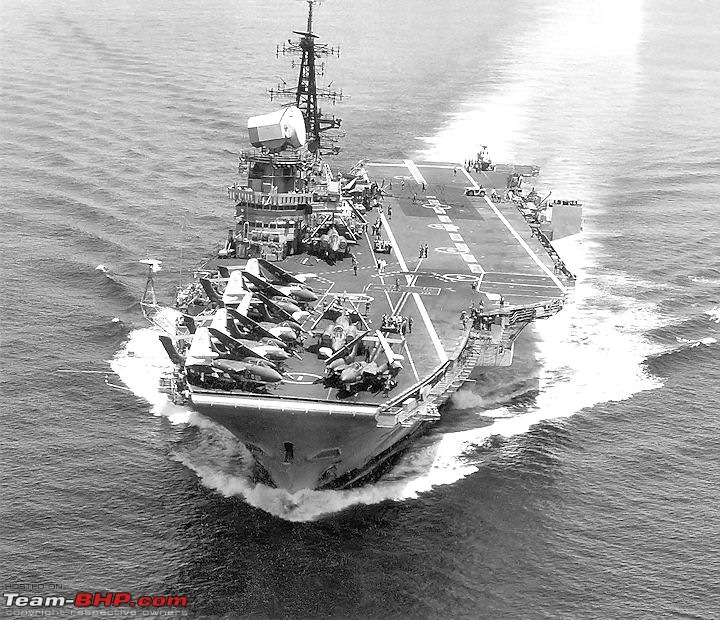
Photo 14A: HMS Hermes as she looked in her hey days in the 1960s. Upfront we can see Sea Vixen fighters and 2 Buccaneer strike aircraft. The box like white structure on top of the bridge is an early generation 3D radar. Note the angled flight deck. 28,700 tonnes full load; 76,000 shp put through two propellers by geared steam turbines; 743 feet long; 28 aircraft carried.
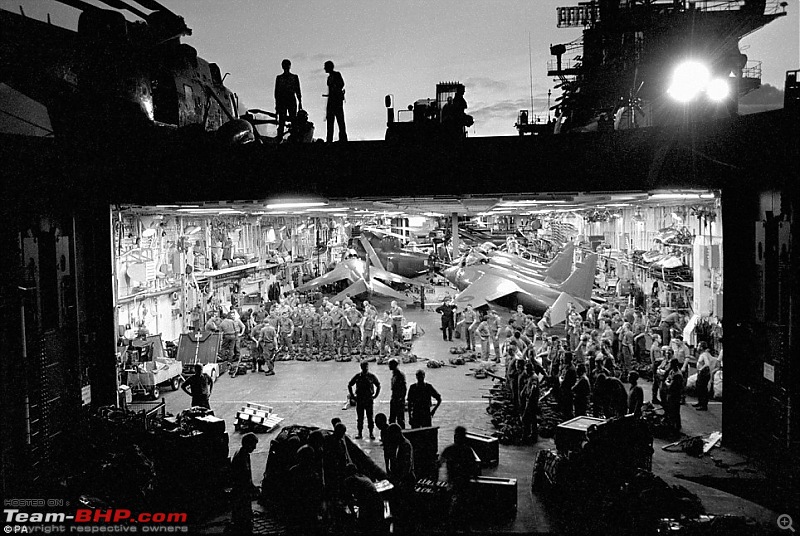
Photo 14B: a most interesting shot taken from the aft deck lift showing both the flight deck and the hangar below. This photo was taken in 1982 as HMS Hermes steamed to the Falklands. Many of the men in the foreground are Royal Navy Marines. Hermes (and of course as Viraat too) could carry on board 750 troops with 4 landing craft for supporting a small amphibious assault.
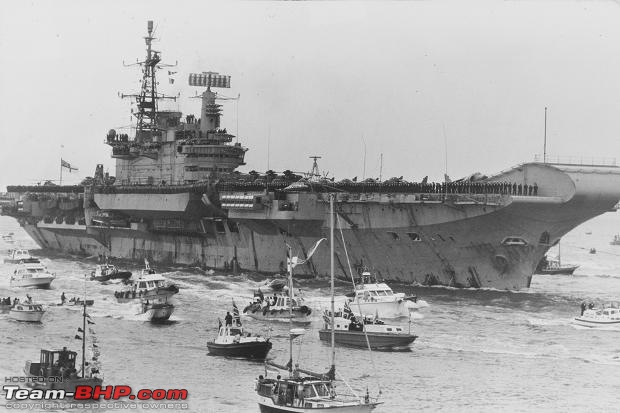
Photo 14C: An iconic photo of HMS Hermes entering Portsmouth harbour after leading the victory in Falklands. A most touching moment for the crew and their families. Note the effect on the ship's hull of the ravages of 4 months at sea.
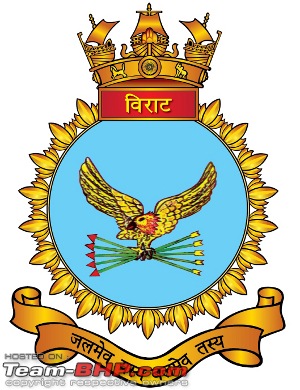
Photo 14D: In 1986 HMS Hermes became INS Viraat. The ships crest shown here. The motto means - 'He who rules over the seas is all powerful'.
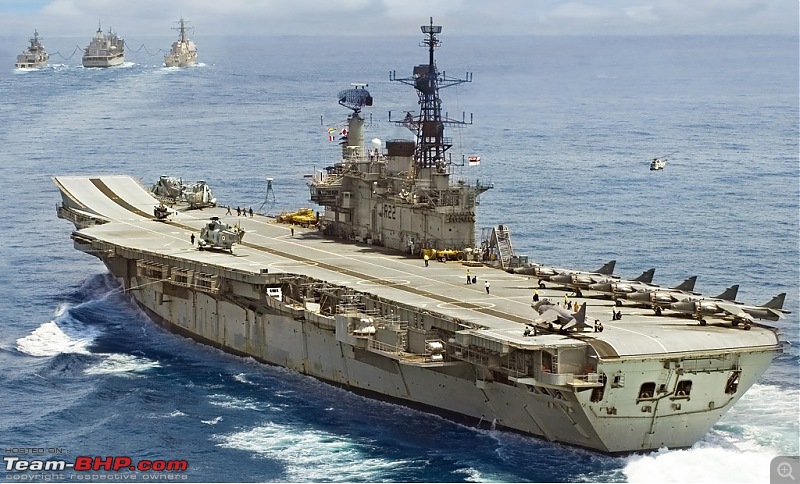
Photo 14E: INS Viraat in Indian Naval service. You can see Sea Harriers and Sea King anti-submarine helicopters on deck, one Alouette III utility/rescue helicopter next to the ski jump and on your right a Seaking turning in to land. In Indian service Viraat has been modernized with new radars, electronic warfare systems, chaff launchers and the redoubtable Barak missile which is an anti-missile defence system.
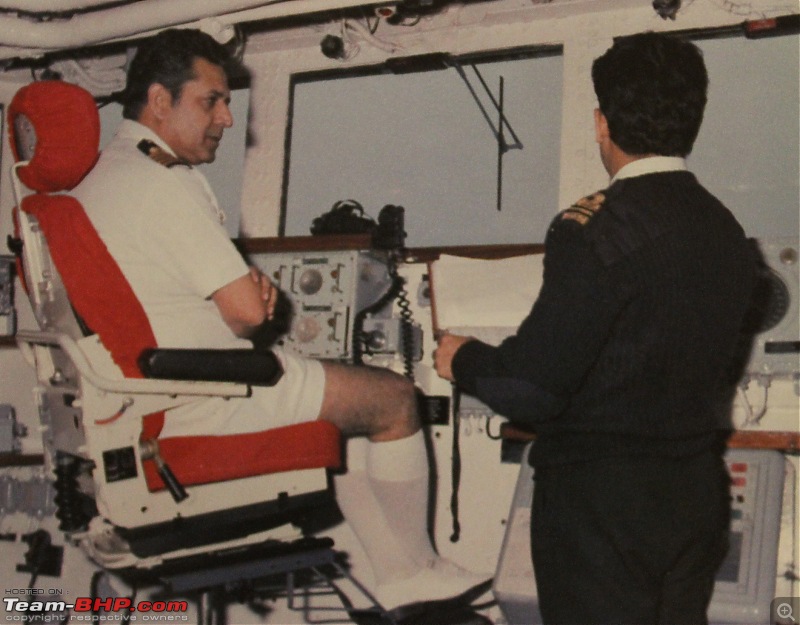
14F:
Captain Vinod Pasricha: The first commanding officer of INS Viraat (seated on left) on the bridge. A ship's cockpit is called a bridge - usually a little larger than a cockpit though! Pasricha wrote the best book so far on Indian Naval Aviation - 'Down Wind Four Green'(
www.pashmira.com). He later rose to be a Vice Admiral and commanded the Western Fleet.
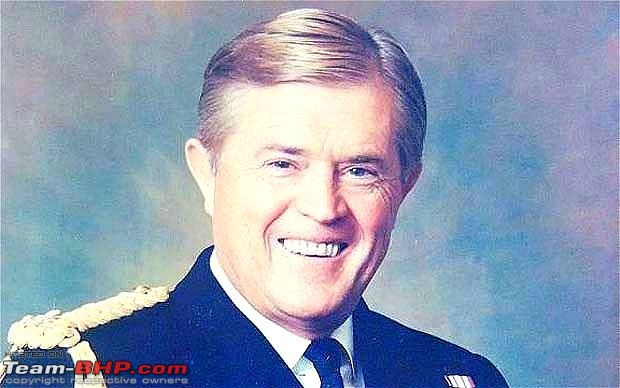
14G:
Captain Linley Middleton (1929-2012): He was the commanding officer of HMS Hermes during its deployment during the Falklands war. He was awarded the Distinguished Service Order for his leadership.
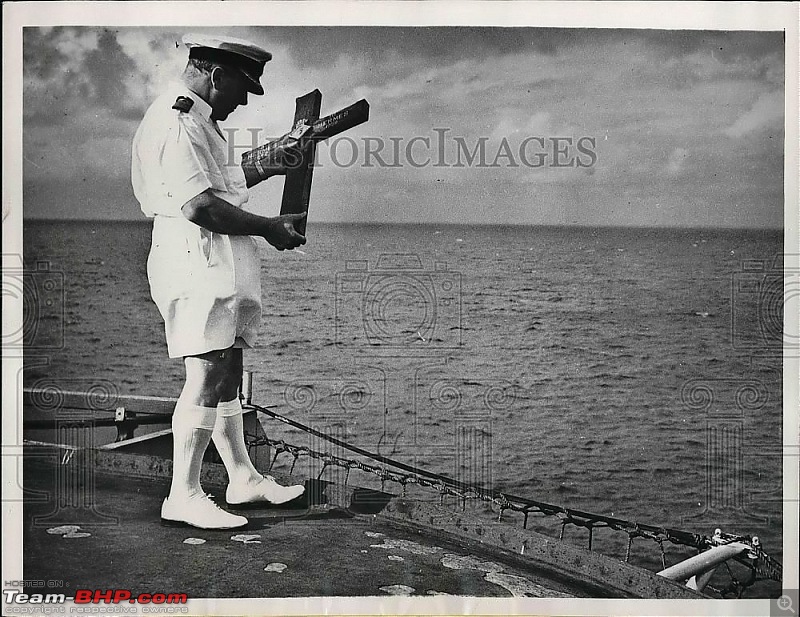
14H:
Captain David Tibbets (1911-2003): The first commanding officer of HMS Hermes. He was a hero from World War II with a note worthy war record against the Germans.
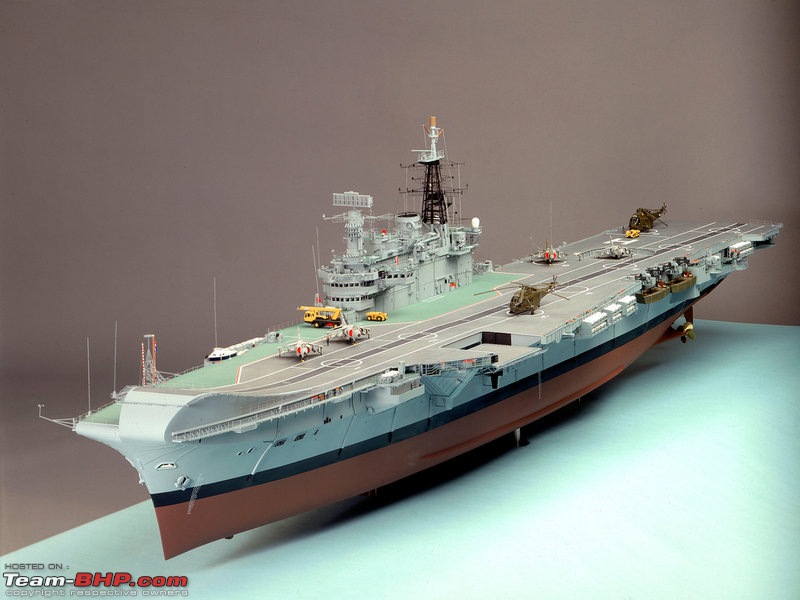
14I: A beautiful scale model.
Aircraft that flew from HMS Hermes/INS Viraat over 56 years (only covering the main aircraft and not those that served in trial or utility roles) 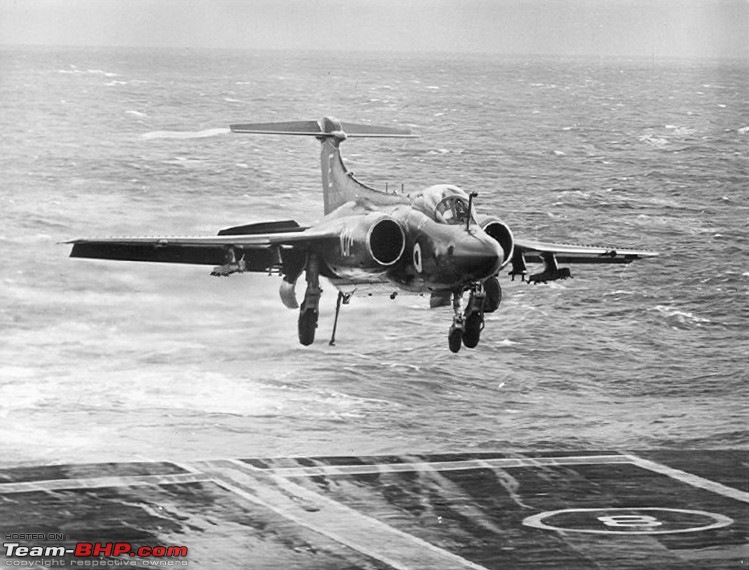
15A: The Blackburn Buccaneer. A twin engine transonic lo-lo attack aircraft that could carry a 16,000 lbs (7257 kgs) weapon payload. It was a long range strike aircraft with excellent low flying qualities. It carried a internal bomb bay in the centre fuselage - a rarity in fast combat jets. The Buccaneer was a most worthy aircraft and a very difficult opponent to catch when flying low.
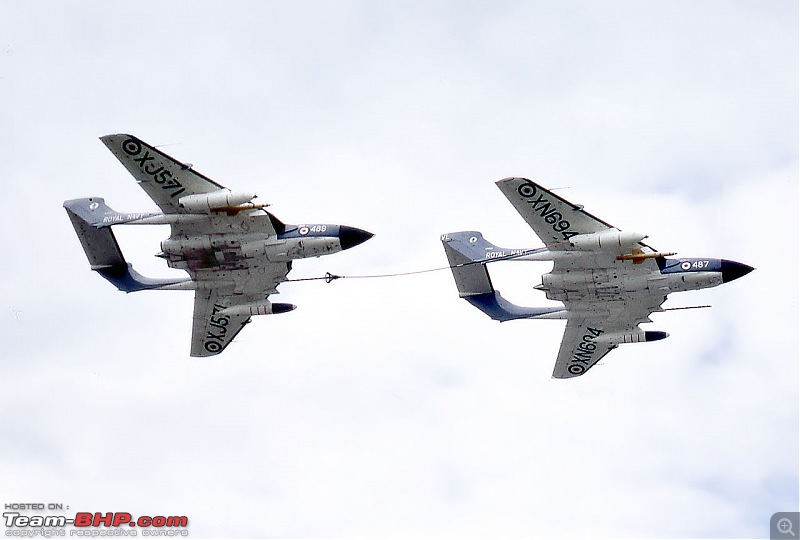
15B: The Sea Vixen a twin jet twin boom fighter that saw limited and mixed service in the Royal Navy and was retired in 1972 after only a dozen years of not so successful service.
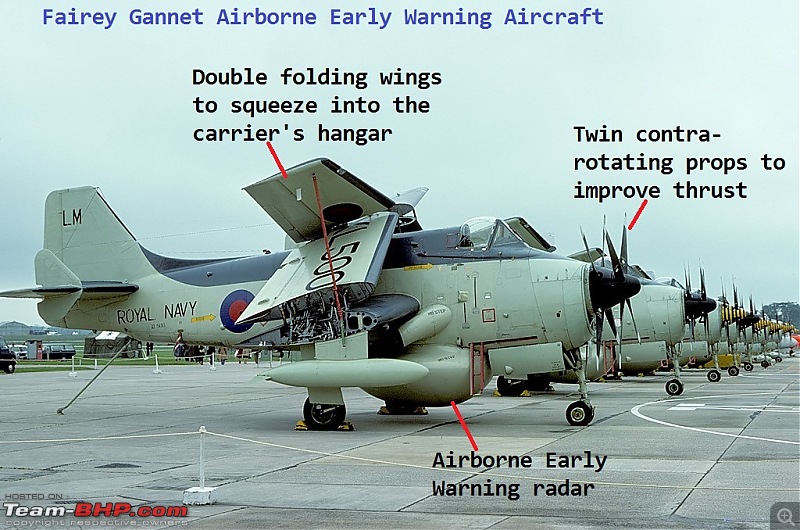
15C:The Fairey Gannet was an odd looking aircraft with an outsized radar under the fuselage and contra rotating propellers. It served on Hermes from 1960 to 1970. Its role was to serve as eyes of the British fleet. The engines put out 3875 hp through those double props. Some say the Gannet was an ugly aircraft. But like babies an aircraft is never ugly…disproportionate maybe but never ugly!
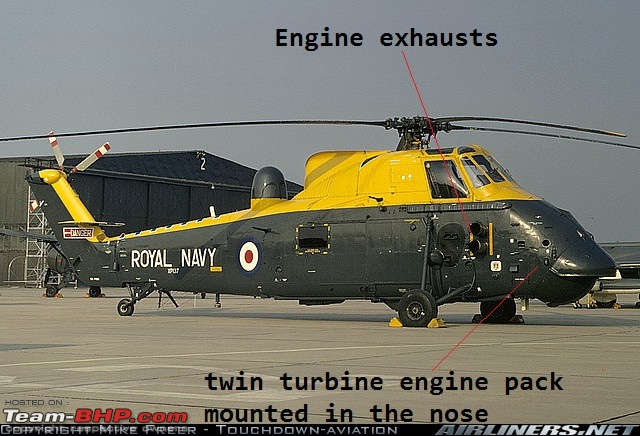
15D: The Westland Wessex helicopter was a first generation machine that served in both anti-submarine and troop assault roles on HMS Hermes. A license built Sikorsky H-34 this was a rugged helicopter that served with the British from 1961 to 2003. A feature of early helicopters was that several had their power plant mounted in the nose with the drive shaft fitted at an angle literally through the cockpit to the rotors at the top. This now seemingly unusual layout was a function of the size of early turbine engines, their gearboxes and the outsized shapes of their air intakes.
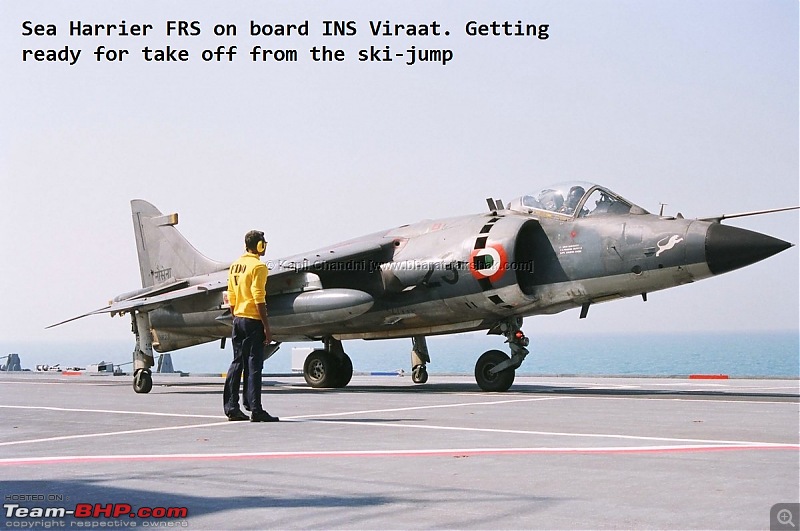
15E: The famous Sea Harrier FRS. FRS stands for Fighter, Reconnaissance and Strike. The Sea Harrier is capable of vertical and short take-offs that increase its versatility tremendously especially on a carrier. The Sea Harrier served under both the British and the Indian navies with success. From 1983 to 2013 it was our primary jet fighter asset at sea. The Harrier is powered by the unique Rolls Royce Pegasus vectored thrust turbofan engine giving ~9750 kgf of thrust. Top speed ~1185 kmph; initial climb rate in clean configuration 50,000 feet/second; intercept radius ~300 nautical miles (550 kms), Armament - typically 2 x 30 mm cannons with 300 rounds and a maximum weapon load of ~3600 kgs. Details of this unique aircraft in post #3
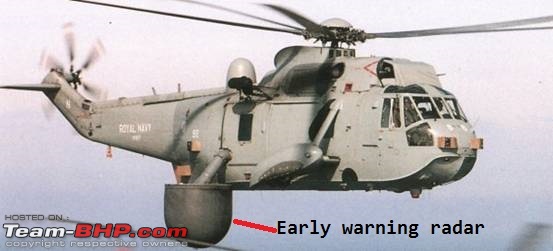
15F: The Seaking AEW (Airborne Early Warning) version which saw service only with the Royal Navy. The radar was flipped down when on radar patrol and flipped up to facilitate landing & take-off. India evaluated this machine but the price was too high and the Russian Ka-31 (see Photo 15I) promised greater capability
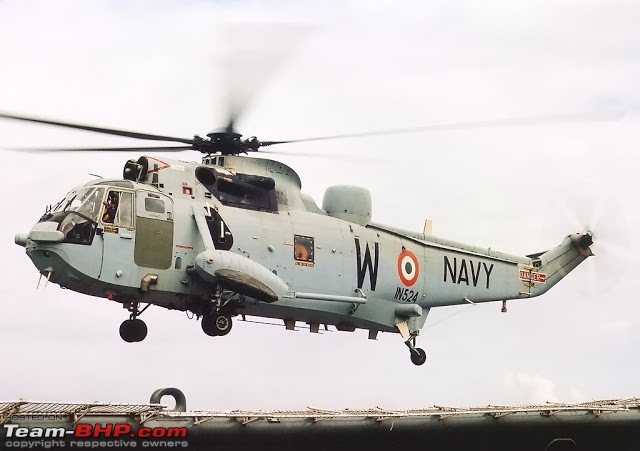
15G: The versatile Westland Seaking which served with both the Indian & the Royal navies in both the anti-submarine variant and the troop assault variant. You can read more in post #2.
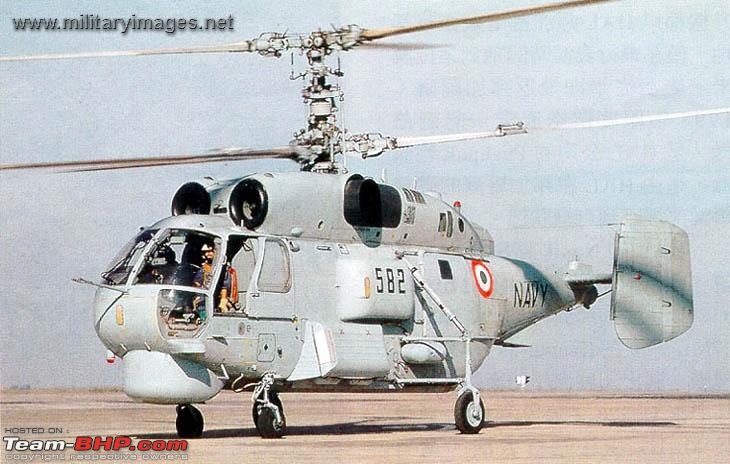
15H: The Kamov Ka-28 anti submarine helicopter served onboard INS Viraat from time to time. It is powered by two Isotov turboshafts that together put through a little over 4400 shp into the contra-rotating props.
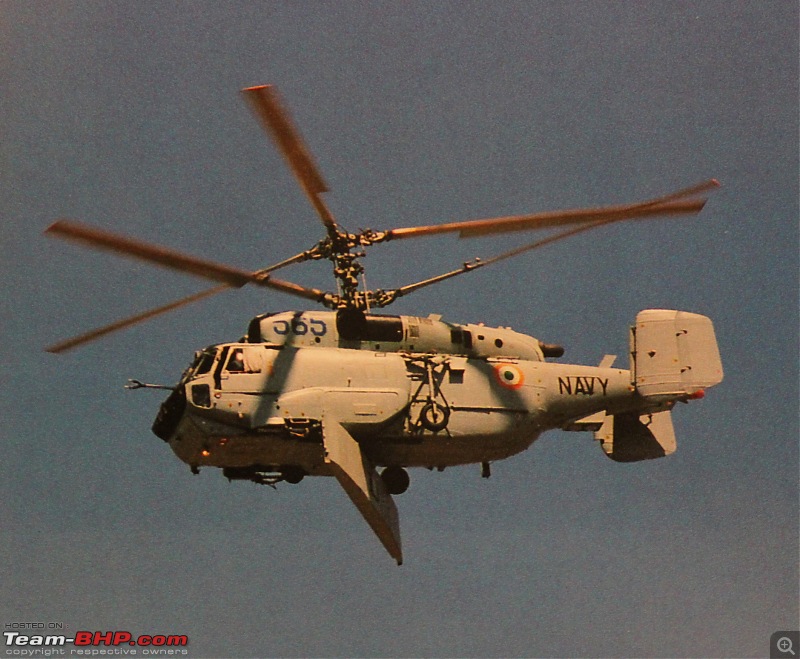
15I: Based on the Kamov Ka-28 is this the Ka-31 which carries a large radar that rotates slowly beneath the airframe and is used for detecting low fast flying aircraft and provide the fleet an early warning. The Ka-31 operates in an integrated network and can transmit to ship or shore what it is 'seeing' for action to be taken.
Jai Hind.
Quote:
Originally Posted by V.Narayan
(Post 3773959)
15I: Based on the Kamov Ka-28 is this the Ka-31 which carries a large radar that rotates slowly beneath the airframe and is used for detecting low fast flying aircraft and provide the fleet an early warning. The Ka-31 operates in an integrated network and can transmit to ship or shore what it is 'seeing' for action to be taken.
Jai Hind.
|
The Ka-28 is based out of Dabolim airport too. I have seen a few of them at the defense end of the airfield. They have a unique shape, almost like a flying box, and with the twin contra rotating aerofoils they present an unmistakable shape.
INS Kochi will be commissioned to Indian Navy today, which is superior in its class and has more advanced sensors and weapons.
Narayan sir waiting for your valuable pointers and in-depth analysis.
Info about INS Kochi. Source: Rediff news.
Quote:
* With a displacement of 7500 tons, the majestic ship spanning 164 meters in length and 17 meters at the beam, is propelled by four gas turbines and designed to achieve speeds in excess of 30 knots.
* The ship has a complement of about 40 officers and 350 sailors. The accommodation and living spaces have been designed with special emphasis on ergonomics and habitability.
* The ship incorporates new design concepts for improved survivability, sea-keeping and manoeuvrability. Enhanced stealth features have been achieved through shaping of hull and use of radar-transparent deck fittings.
* Kochi is packed with an array of state-of-the-art weapons and sensors, with a significant indigenous component. The ship thus has many lethal weapons to her credit which include the supersonc Brahmos missile.
|
http://www.rediff.com/news/report/de...h/20150930.htm
Quote:
Originally Posted by Nempuguru
(Post 3814527)
INS Kochi will be commissioned to Indian Navy today, which is superior in its class and has more advanced sensors and weapons.
Narayan, waiting for your valuable pointers and in-depth analysis.
|
@Nempuguru, I'll post some photos taken at the commissioning ceremony earlier today on the new thread "INS Kochi commissioned" created by @Holydriver. Flattered you want my views:) I had the joy of a guided tour down into the bowels of the mighty ship. I would love to write a thread on the history and development of the destroyers of the Navy from the first INS Ranjit in 1950 to the latest Kochi class. Will do one day.
Quote:
Originally Posted by TKMCE
(Post 3827126)
|
Thank you for sharing. A piece of our military history has passed away. One more great sailor and aviator sails over the horizon. Tahiliani was the first Indian naval aviator to land on INS Vikrant in 1961. Later he was the first naval aviator to rise to be the naval chief. You can see that first landing in the first post of this thread.
On the occasion of the International Fleet Review, at Vizag, the Navy released quite a few high resolution photographs. I have picked some of them related to Naval Aviation for your viewing pleasure.
In India, the President, as the Supreme Commander of the armed forces, reviews the Fleet once during his tenure. Ten Reviews have taken place in India since Independence in 1947. The first was held in 1953 and the last prior to International Fleet Review 2016, in 2011.
In this most formal of naval ceremonies, vessels from all commands are anchored in lines at the precise spot allotted to them. After a 21-gun salute, the President embarks on the Presidential yacht, distinguishable by the Ashoka emblem on her side and reviews all the ships by cruising past them. Each ship is manned by her ship’s company, dressed in white ceremonial uniforms. In a moment that stands still in time, white caps are doffed in unison in a grand salutation. The resounding sound of ‘Three Jais’ echoes over the waves, carrying the promise of the allegiance of each and every sailor and officer to the State and the President, their Supreme Commander.
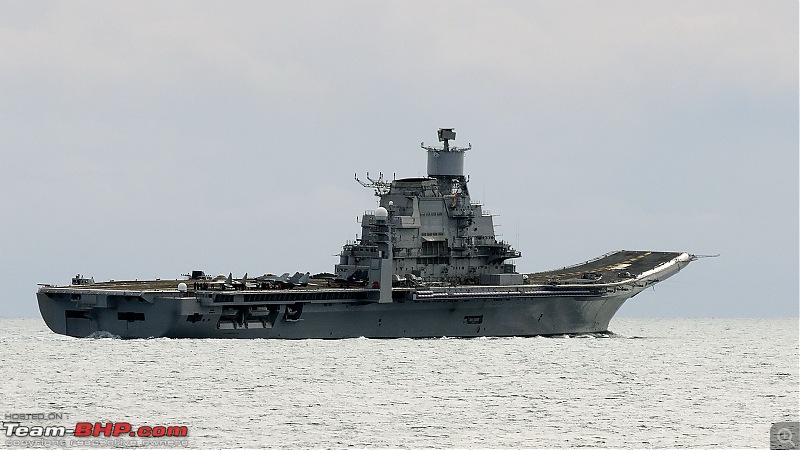
A1. INS Vikramaditya the Navy's most photographed ship. All of 44,000 tonnes, 273 metres of length and 180,000 shp of steam turbine power. Sails 25,000 kms on a tank full at 18 knots (33 kmph). If you drop the speed to 14 knots she'll go 50,000 kms give or take a little. Can carry up to a maximum of 36 aircraft including the Mig-29K multi-role combat aircraft
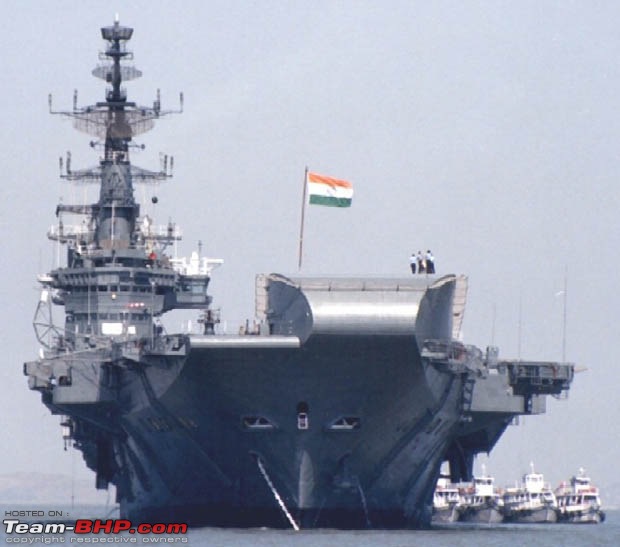
A2. INS Viraat. Our outgoing aircraft carrier. She retires from service soon after this fleet review. Served as our most powerful ship from 1987 to 2013. A whole generation of naval aviators came of age flying from her deck. It is a testimony to her British design and that she lasted this long and to Indian naval engineers who nursed her these last 29 years. She is 57 years old.
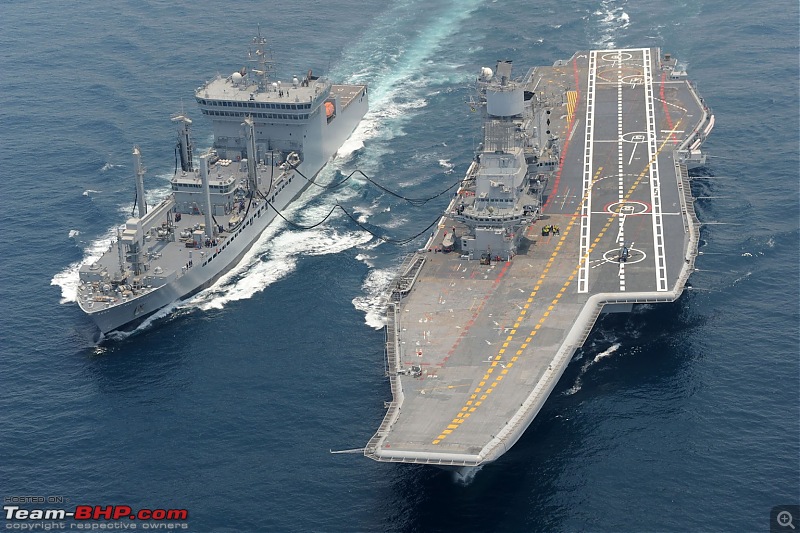
A3 INS Vikramaditya taking on fuel and stores from a Deepak class underway replenishment ship. Underway replenishment is vital to keep the fleet at sea for long periods. The replenishment ship is itself quite large at 27,500 tonnes and 175 metres long but it is dwarfed by Vikramaditya
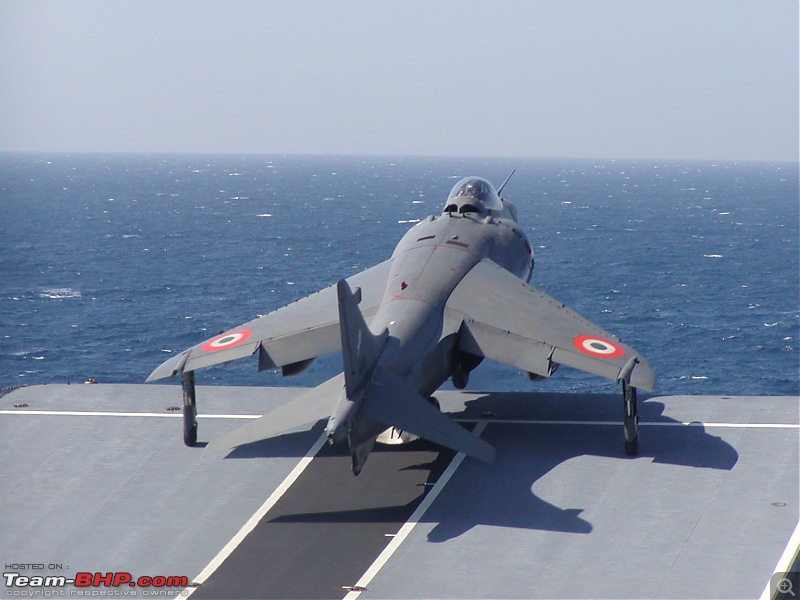
A4. Sea Harrier at the instant of take off from INS Viraat's ramp. This sight we will soon not see again.
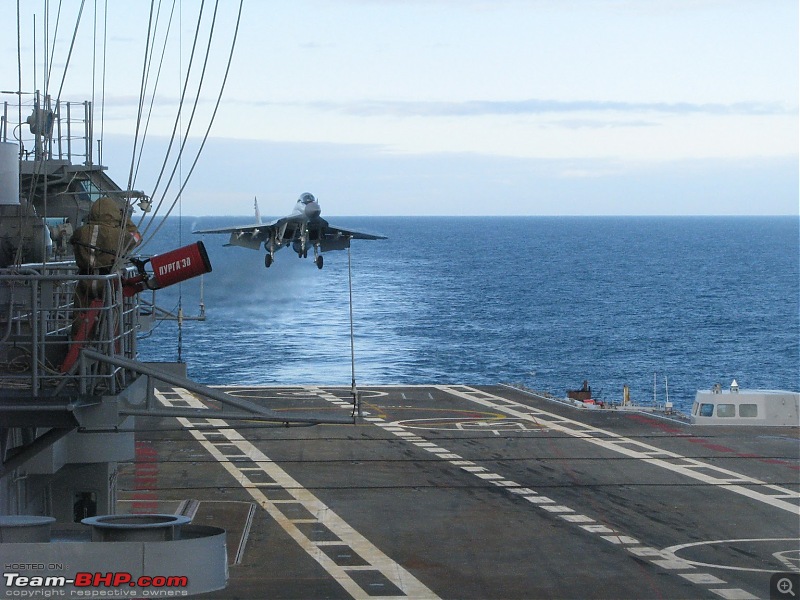
A5. Mig-29K milliseconds before touchdown on INS Vikramaditya. It aims to hook one of the arrestor wires seen straddling the deck
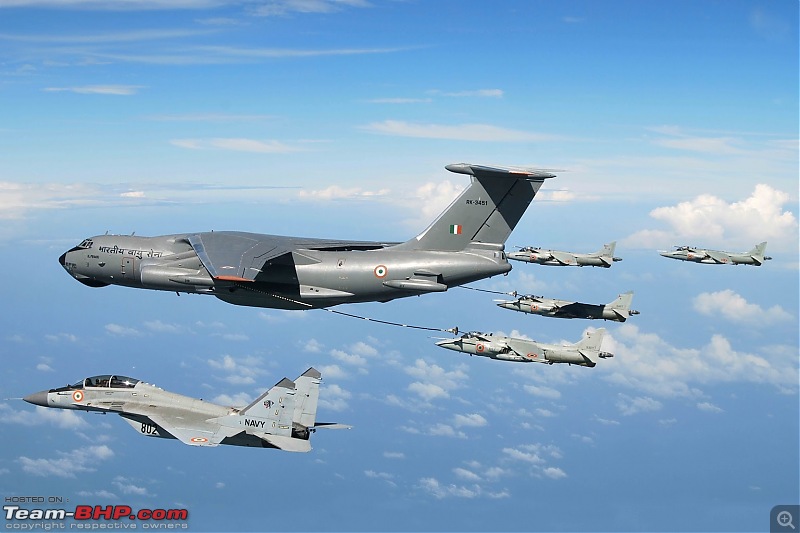
A6. A perfect PR shot for Naval Aviation. An Ilyushin IL-78 tanker refueling 3 Sea Harriers in mid-air while a Mig-29K and another Sea Harrier escort them.
The IL-78 can carry up to 85 tonnes of fuel most of which can be used for mid-air refuelling.
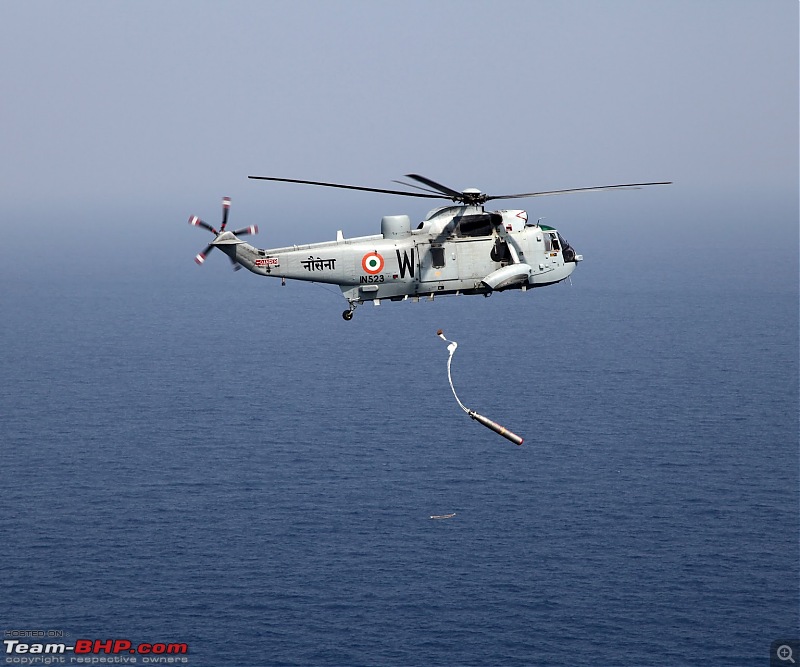
A7. Seaking helicopter dropping an anti-submarine homing torpedo into the sea. On getting underwater the torpedoes sonar will initiate a search pattern for the target submarine.
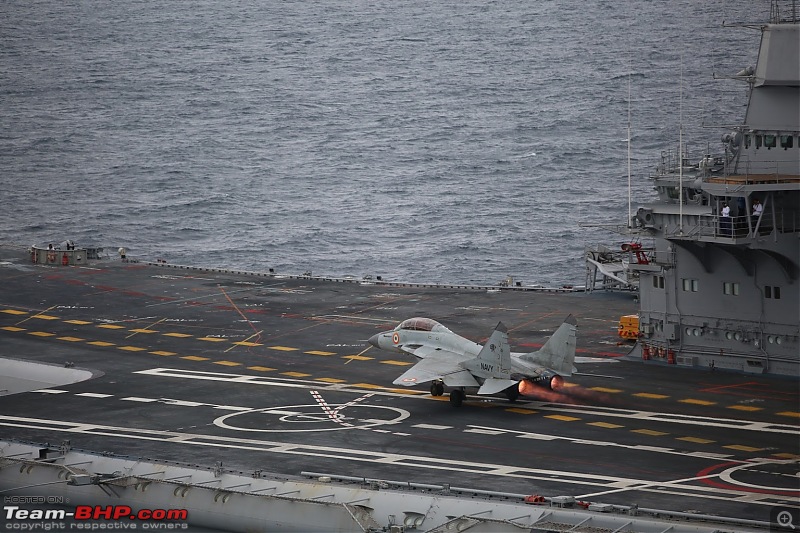
A8. Mig-29K on its take-off run with full after burners just before hitting the ramp on INS Vikramaditya. At this moment the 2 engines are putting out a combined thrust of 18,000 kgf. Converting kgf to bhp is wrought with risk. But going by aero turbines that were developed into marine propulsion turbines I would say that is around 54,000 bhp.
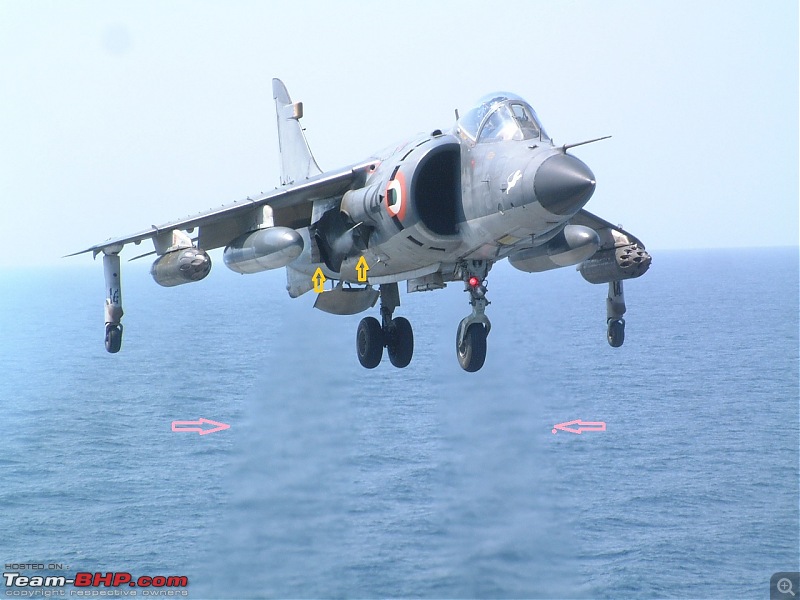
A9. Sea Harrier in vertical mode. These will now operate possibly from INS Vikramaditya after INS Viraat is decommissioned. Possibly the most unique jet fighter built. The yellow arrows show the right side nozzles swilled 90 degrees down to create a column of jet thrust (pink arrows) on which the aircraft is literally standing.
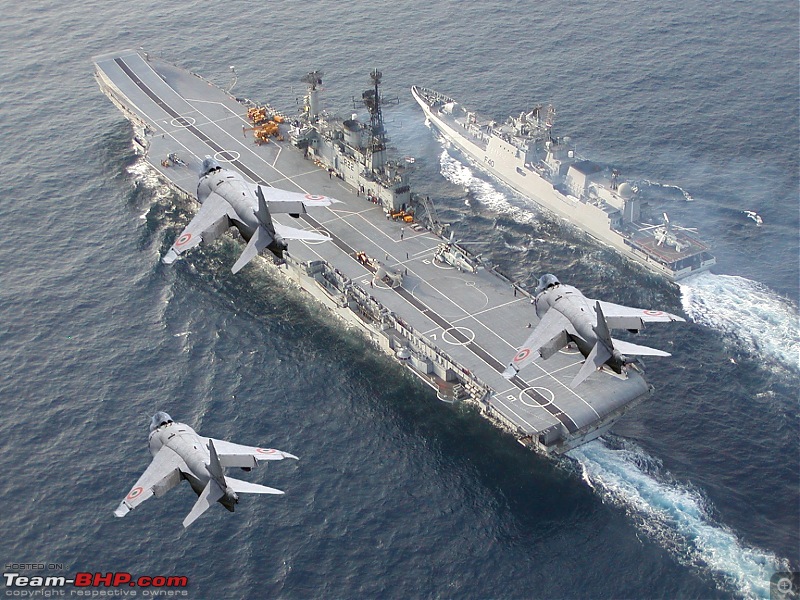
A10. Three Sea Harriers fly past INS Viraat. A Talwar class frigate abeam with its integral Kamov Ka-28 ASW (anti-submarine warfare) chopper on the aft flight deck.
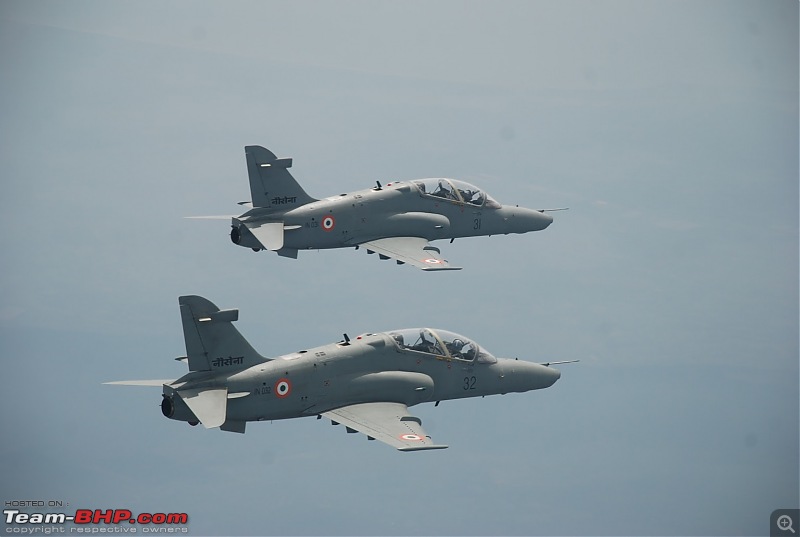
A11. BAe Hawks - advanced jet trainers used by both the Navy and the IAF. Our bureaucracy took 25 years, yes 25 years, to close the purchase (and license build) of this fine trainer. In the meantime several young IAF pilot lost their lives, in the flower of their youth, trying to transition from Kiran trainers to Mig-21's. That is like learning to drive on a Maruti M800 and then being geared up for the Formula F.1 straight away. Needless to say no bureaucrat ever answered for this.
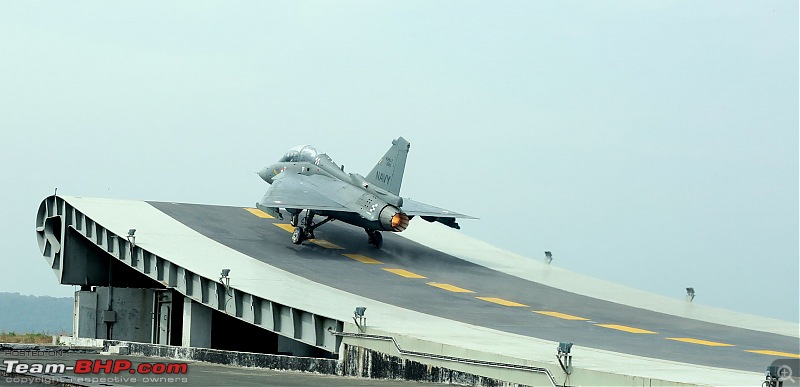
A12. The Naval Tejas undergoing ramp take off tests.
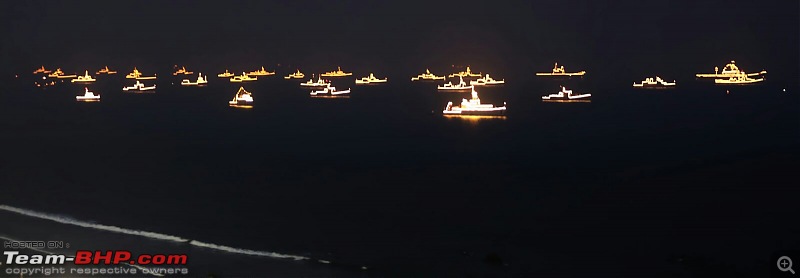
A13. Vizag harbor lit up with the ships under review
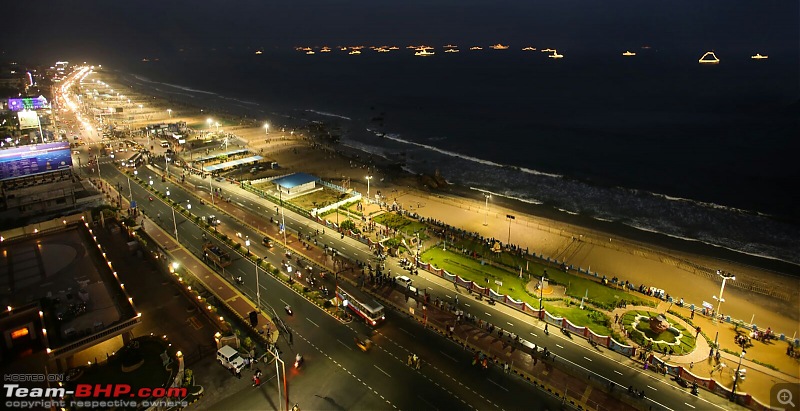
A14. Beach Road Vizag on the eve of the International Fleet Review. I used to live on this road in 1981 when it had all of 3 dozen houses on a 7 kms stretch with Sun & Sea Hotel somewhere in between. Visited in 2013 and I couldn't locate our old house for half an hour! Vizag is a bustling throbbing city today.
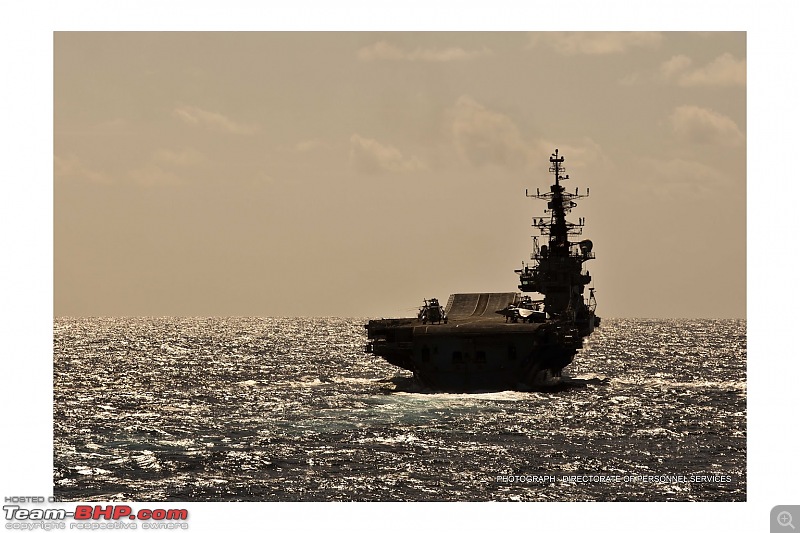
A15. INS Viraat will sail away over the horizon after the fleet review.
Thanks V.Narayan, for another very informative and very well researched post.
Just would like to add a bit of trivia about the rival to the Sea Harrier which you said is "Possibly the most unique jet fighter built."
Although Sea Harrier is much more famous, the first jet aircraft to enter service which was capable of Vertical Take off and landing on board a ship was the Russian Yakovlev Yak-38. It entered into service two years before the Sea Harrier (1978 vs 1980)
https://en.wikipedia.org/wiki/Yakovlev_Yak-38
Slightly off topic. But did anyone hear/see fighters take off from Mumbai domestic airport noon time. Seen them for past few days take off from the maintenance runway. Managed to take a picture but it's poor quality. Is there a better sound and sight than a fighter jet take off ?
| All times are GMT +5.5. The time now is 03:00. | |


































